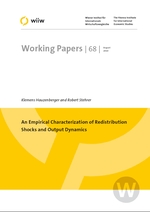An Empirical Characterization of Redistribution Shocks and Output Dynamics
Klemens Hauzenberger and Robert Stehrer
wiiw Working Paper No. 68, August 2010
47 pages including 6 Tables and 4 Figures
What are the economic effects of redistributing one dollar from profits to labour income? We address this question for the post-World War II economies of the United States and Canada within a structural VECM procedure allowing for up to two breaks of unknown timing. In the United States the short-run spending effect on growth, set in motion by higher labour income, is strong enough to make such a redistribution an attractive, maybe provocative, policy alternative. Across the border in Canada, however, the negative medium-run capacity effect, brought about by diminished profits, dominates the picture more or less from the beginning and output slumps considerably, a result actually suggesting a - maybe even more provocative - redistribution towards profits. We discuss several possible explanations such as the formation of expectations and the different exposure to international trade. Methodologically, we provide a novel procedure to estimate cointegrating rank and break dates jointly.
Keywords: redistribution, structural VECM, joint estimation of cointegrating rank and multiple break dates
JEL classification: C32, C53, E12, E25
Countries covered: Canada, USA
Research Areas: Macroeconomic Analysis and Policy
